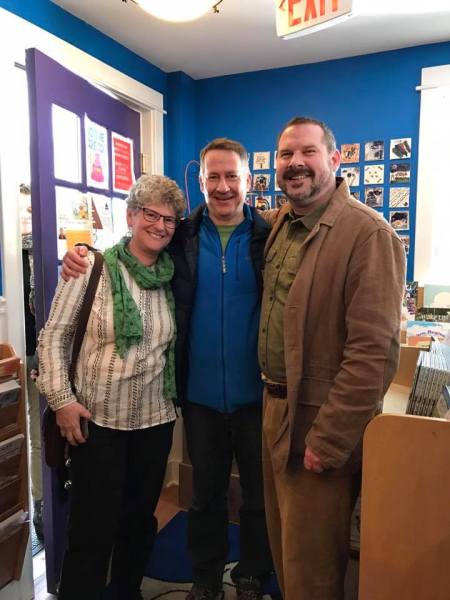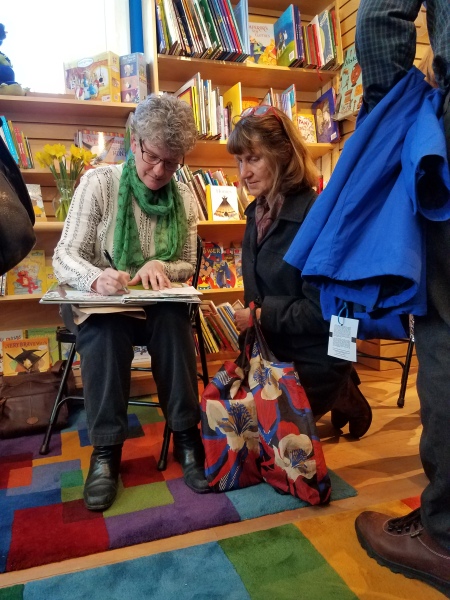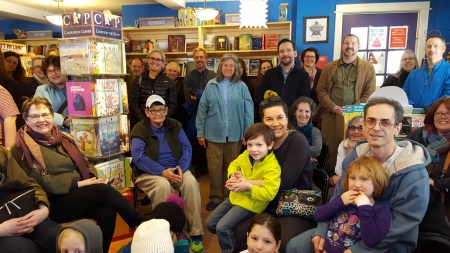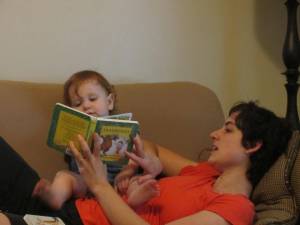Maybe you can’t go home again. But sometimes, if you’re extraordinarily lucky, you get to stop by for a gratifying visit. That’s how lucky I was last weekend, when I returned to Vermont to celebrate the publication of my first book in twelve years – titled, appropriately enough, Are We Still Friends?

Just a fraction of the crowd at The Flying Pig
During the two decades my family lived in Burlington, we laid down a wide network of deep roots. Between neighbors, school and library connections, local politics, synagogue, kid-lit circles, David’s work at UVM and mine at Seven Days newspaper, we got attached to an awful lot of people. When we moved to Rhode Island 10 years ago, an awful lot of those friends stayed in Vermont. And thanks to the magic of the interwebs, we’ve been able to keep in touch.

With Chris Tebbets and Joe Nusbaum, one half of my online critique group…in the flesh!
When my son’s preschool sweetheart had a baby, I saw the pictures. When writers I’d edited and mentored wrote great articles and published books, I kvelled. I followed friends’ and allies political and professional careers, commiserated over deaths, watched kids grow up, go away to school and start careers….and through it all, kept our Vermont peeps up to date about our milestones. Needless to say, when the baby I’d held as a newborn got ready to became a bat mitzvah just a few weeks after my book was to be released, I jumped at the chance to share both events with my old friends.

With Elizabeth Bluemle children’s author and bookseller extraordinaire
The bat mitzvah was on Saturday, so I arranged to do a book launch at Flying Pig Bookstore in Shelburne on Sunday. I posted the event on Facebook and Twitter, and wrote about it on my children’s writer website. I made up special postcards and sent them to 100 people, including personalized notes; if I knew the name of someone’s grandchild, I used it. In some cases, I followed up with emails.

It felt a little bit like my old days in politics — trying to accurately ID likely voters and then make sure they vote. And it was almost as nerve-wracking. What if they held an election, I mean, a book-signing, and nobody came? I lost some sleep and suffered through some stomach cramps. But that turned out to be all I suffered. The folks at Flying Pig were as welcoming and well-organized as any bookstore people I’ve ever worked with. More importantly, though, my friends came through. Like crazy.

With my wonderful friend Trish Hanson, the entomologist behind Breakout at the Bug Lab
They just kept pouring in through the door, each with a huge grin and a big hug. It was actually sort of overwhelming. But in the very best possible way. I am stunned and thrilled and oh, so very grateful to everyone who came – and to those who couldn’t make it, but wanted to. (We would have found a way to squeeze you into that room, but we wouldn’t have had enough books.)

Thank you all for still being my friends! I sure hope you like the book!






